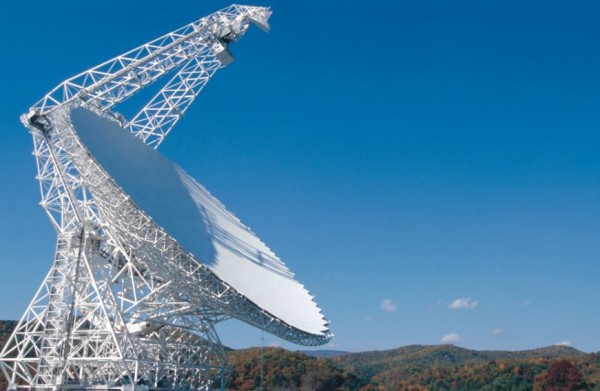By Arthur Dominic J. Villasanta , | April 20, 2017

Green Bank Telescope in West Virginia.
Breakthrough Listen, the initiative to find signs of intelligent alien life in the universe, has released its 11 events ranked highest for significance as well as summary data analysis results and the results have been disappointing so far.
Breakthrough Listen said it's considered unlikely any of these signals originate from artificial extraterrestrial sources, but the search continues.
Like Us on Facebook
"Although the search has not yet detected a convincing signal from extraterrestrial intelligence, these are early days. The work that has been completed so far provides a launch pad for deeper and more comprehensive analysis to come," said Andrew Siemion, Director University of California Berkeley's SETI Research Center (BSRC).
Breakthrough Listen has submitted for publication to a leading astrophysics journal the analysis of 692 stars (comprising all spectral types) observed during its first year of observations with the Robert C. Byrd Green Bank Telescope (GBT) in West Virginia, the world's largest fully steerable radio telescope.
The Berkeley SETI Research Center Breakthrough Listen science team examined data on 692 stars from the primary target list from GBT, consisting of three five-minute observations per star, interspersed with five-minute observations of a set of secondary targets.
Breakthrough Listen has so far acquired several petabytes of data using GBT; Lick Observatory's Automated Planet Finder on Mt. Hamilton in California and the Parkes Radio Telescope in Australia.
The Breakthrough Listen science team at the BSRC designed and built an analysis pipeline that scans through billions of radio channels in a search for unique signals that might indicate the presence of technology developed by civilizations outside our Solar System.
Initial results from deploying this pipeline on the first year of Breakthrough Listen data taken with the "L-band" receiver at GBT (covering frequencies from 1.1 - 1.9 GHz) have been submitted for publication in one of the world's leading astronomy journals.
Snapshot data has been released for the 11 highest ranked events that rose above the pipeline's threshold for significance, as well as summary results from the complete analysis.
Data is available at www.breakthroughinitiatives.org/OpenDataSearch.
"With the submission of this paper, the first scientific results from Breakthrough Listen are now available for the world to review," said Siemion.
The basics of searching for signatures of extraterrestrial technology are quite simple. Artificial signals can be distinguished from natural processes through features like narrow bandwidth; irregular spectral behavior, pulsing, or modulation patterns; as well as broad-band signals with unusual characteristics.
Human technology, however, emits signals (known as radio frequency interference) similar to the ones being searched for. This means that algorithms must be designed to ensure that signals are coming from a fixed point relative to the stars or other targets being observed, and not from local interferers (including Earth-orbiting satellites).
-
Use of Coronavirus Pandemic Drones Raises Privacy Concerns: Drones Spread Fear, Local Officials Say

-
Coronavirus Hampers The Delivery Of Lockheed Martin F-35 Stealth Fighters For 2020

-
Instagram Speeds Up Plans to Add Account Memorialization Feature Due to COVID-19 Deaths

-
NASA: Perseverance Plans to Bring 'Mars Rock' to Earth in 2031

-
600 Dead And 3,000 In The Hospital as Iranians Believed Drinking High-Concentrations of Alcohol Can Cure The Coronavirus

-
600 Dead And 3,000 In The Hospital as Iranians Believed Drinking High-Concentrations of Alcohol Can Cure The Coronavirus

-
COVID-19: Doctors, Nurses Use Virtual Reality to Learn New Skills in Treating Coronavirus Patients










